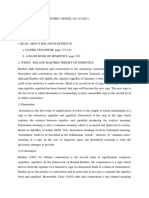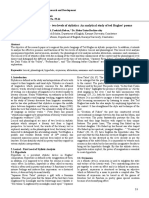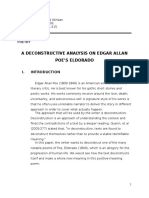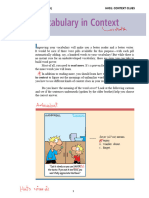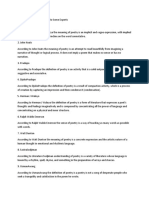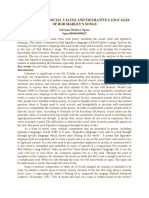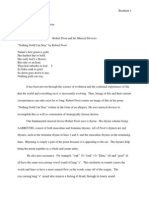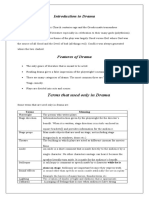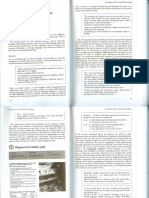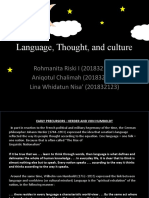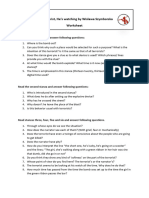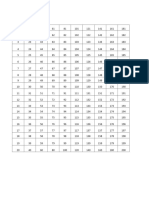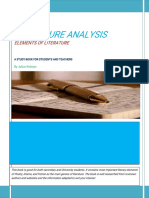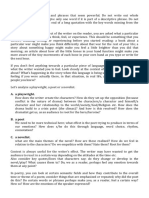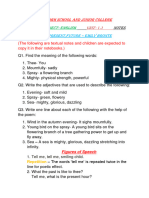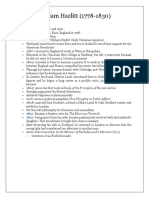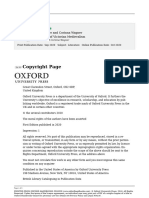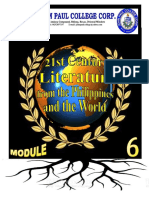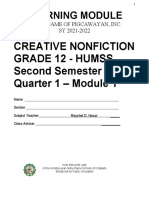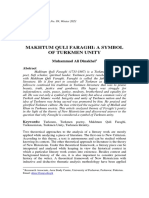0 ratings0% found this document useful (0 votes)
264 viewsSummary Poetry Meeting 3 4 5
Summary Poetry Meeting 3 4 5
Uploaded by
Maulana BomoThe document summarizes discussions from meetings 3-5 about analyzing poems. Meeting 3 discusses the poem "Hair" which explores the speaker's frustration with their hair and treatments over time. Meeting 4 examines the poem "The Eagle" which depicts the mighty bird's high perch and powerful dives through imagery. Meeting 5 analyzes "Let Dogs Delight to Bark and Bite" contrasting animals' nature to bark, bite, growl and fight with the instruction for children not to hurt each other even when angry.
Copyright:
© All Rights Reserved
Available Formats
Download as DOCX, PDF, TXT or read online from Scribd
Summary Poetry Meeting 3 4 5
Summary Poetry Meeting 3 4 5
Uploaded by
Maulana Bomo0 ratings0% found this document useful (0 votes)
264 views4 pagesThe document summarizes discussions from meetings 3-5 about analyzing poems. Meeting 3 discusses the poem "Hair" which explores the speaker's frustration with their hair and treatments over time. Meeting 4 examines the poem "The Eagle" which depicts the mighty bird's high perch and powerful dives through imagery. Meeting 5 analyzes "Let Dogs Delight to Bark and Bite" contrasting animals' nature to bark, bite, growl and fight with the instruction for children not to hurt each other even when angry.
Copyright
© © All Rights Reserved
Available Formats
DOCX, PDF, TXT or read online from Scribd
Share this document
Did you find this document useful?
Is this content inappropriate?
The document summarizes discussions from meetings 3-5 about analyzing poems. Meeting 3 discusses the poem "Hair" which explores the speaker's frustration with their hair and treatments over time. Meeting 4 examines the poem "The Eagle" which depicts the mighty bird's high perch and powerful dives through imagery. Meeting 5 analyzes "Let Dogs Delight to Bark and Bite" contrasting animals' nature to bark, bite, growl and fight with the instruction for children not to hurt each other even when angry.
Copyright:
© All Rights Reserved
Available Formats
Download as DOCX, PDF, TXT or read online from Scribd
Download as docx, pdf, or txt
0 ratings0% found this document useful (0 votes)
264 views4 pagesSummary Poetry Meeting 3 4 5
Summary Poetry Meeting 3 4 5
Uploaded by
Maulana BomoThe document summarizes discussions from meetings 3-5 about analyzing poems. Meeting 3 discusses the poem "Hair" which explores the speaker's frustration with their hair and treatments over time. Meeting 4 examines the poem "The Eagle" which depicts the mighty bird's high perch and powerful dives through imagery. Meeting 5 analyzes "Let Dogs Delight to Bark and Bite" contrasting animals' nature to bark, bite, growl and fight with the instruction for children not to hurt each other even when angry.
Copyright:
© All Rights Reserved
Available Formats
Download as DOCX, PDF, TXT or read online from Scribd
Download as docx, pdf, or txt
You are on page 1of 4
Summary e-learning Meeting 3, 4, 5:
HOW TO ANALYZE A POEM:
1. Read the poem more than once
Sometimes, it helps to read the poem aloud. It will make you realize the rhyme and the rhythm.
2. Take notes
When you read for the second time, consult your dictionary for any unfamiliar words.
Remember the main point of Poetry is dictions. An English word may have several meanings.
Therefore, making sure you know the meaning of each word will help you get more
understanding of the poem.
3. Identify the poetic devices
Look for rhymes, repetition, imagery. Again, diction matters. The rhymes are used for a certain
intention.
4. Identify the speaker
Who tells the poem?
Does the poem give any clues about the speaker’s personality, the point of view, age, or gender?
Who is the speaker addressing?
Does the speaker seem attached or detached from what is said?
5. Discover the story
What is the subject? (or What is the speaker talking about?)
What situation is the speaker in?
How does the speaker think about the subject?
6. Examine the title
Does the title immediately change how you think about it?
Does the poem’s title paint a picture that gives a specific time frame, setting or action?
Does it imply multiple possibilities?
Meeting-3: “Hair” by Max Fatchen
The poem “Hair” consists of 24 lines divides into 12 stanzas each of which has 2 rhymed lines.
The speaker talks about hair, how the hair becomes the speaker’s tension, “I despair/ about hair/
with all the fuss” (line 1-3) “and flurries/ and worries” (line 13-14). According to the speaker, the
state of hair is part of physical appearance, thus, hair needs treatments, such as “... nipping/ and
clipping/ ... curling/and twirling” (lines 5- 8), “... lopping/ and flopping” (lines 11-12). Those
treatments are done one after another as the speaker lives as can be implied in line 20, “when
you’re older”. This line suggests that no matter how many treatments the speaker has done, the
state of hair is always his/her concern. The last four lines depict the speaker’s frustration, “[the
hair] turns grey/ or goes away/ or leaves a fuzz” (line 21-23). This frustration is marked by the
use of exclamation mark, “Hair does!” (line 24).
Meeting-4: “The Eagle” by Alfred Lord Tennyson
The poem consists of two stanzas, each has three lines.
The first stanza rhymes a-a-a follows with the second stanza rhymes a-a-a
These rhymes have meanings that can be revealed or felt after you examine each line of the two
stanzas.
Line 1: He clasps the crag with crooked hands,
The word “he” implies that the eagle is personified as a man who has “hands”
Line 2: Close to the sun in lonely lands,
Line 3: Ring’d with the azure world, he stands.
These two lines describe the eagle’s position: it stands alone, “lonely lands” on a very high place,
“close to the sun” surrounds by the sky, “azure world”
Line 4: The wrinkled sea beneath him crawls,
This line hints that the sea is below his high position
The sea is personified as human, “wrinkled” and “crawls” to give the image of the waves of the
sea.
Line 5: He watches from his mountain walls,
The phrase “mountain walls” refers to “crag” mentioned in the first line.
Line 6: And like a thunderbolt he falls.
Here, a simile is used; the eagle turns down from the sky just like a thunderbolt.
Each line ends with ‘s’ sound as auditory imagery of the sounds: the pieces of the crag that fall,
the wind, and the sea waves.
It can be concluded that the poem, just like the title says, talks about an eagle.
The speaker illustrates the eagle with admiration as can be felt by the dictions from the beginning
until the end; the eagle is a mighty creature that can conquer the sky and the water. The last line
shows that such power is needed to catch his prey, fish in the sea.
Meeting-5: “Let Dogs Delight to Bark and Bite” by Issac Watts
The speaker differentiates animals and humans’ characteristics. The animals are mentioned in the
first and the third lines: “dogs,” “bears,” and “lions,” while humans are represented by the phrase
“children” in the fifth line. The phrase “their nature” (line 4) refers to the animals’ characteristics
which are “bark and bite” (line 1) and “growl and fight” (line 3). Those characteristics have
negative meanings as referred by “such angry passions” (line 6). It can be concluded that when
animals are angry, they will bark, bite, growl, or fight. Here, the phrases bark and growl suggest
being harsh by screaming or hurting others’ feelings verbally while the phrases bite and fight
suggest being mean by hurting others physically. These characteristics must not be possessed by
humans as inferred in lines 5-6. The word “but” (line 5) implies the opposition between animals
and humans. The phrase “should never let” (line 5) means humans are capable to do those things,
the animals’ characteristics, but the speaker advises not to let that happens. The animals are
created to behave such ways, “[f]or God hath made them so” (line 2), it is their natures to bark,
bite, growl, and fight. However, according to the speaker, humans are not made to be like
animals, “[y]our little hands were never made/ [t]o tear each other’s eyes” (lines 7-8). The phrase
“your little hands” (line 7) refers to the word “children” (line 5). Thus, the speaker wants humans
not to behave like those animals even when they are angry. The phrase “tear each other’ eyes”
(line 8) implies making someone cries. Therefore, the speaker instructs human children to not
hurt each other, either verbally or physically, even when they are in disagreement. This
instruction is emphasized by the repetition of the title in the first line.
Notes for your answers:
1. You must explain your answer. Your answer is unclear if you only make a single
sentence.
2. You must quote the word, phrases, and lines of the poem. To argue means to provide
evidence of the base of your interpretation. Quoting one phrase or one line is not enough.
A poem may have several lines and each line connects to other lines. The more lines you
quote, the more your explanation will be. Do not quote more than two lines for a single
interpretation.
3. You must explain each quoted line. The main point of poetry is dictions. Therefore,
discuss the dictions, explain each word. This is done to make a strong argument of your
interpretation.
You might also like
- The Drama of Speech Acts: Shakespeare's Lancastrian TetralogyFrom EverandThe Drama of Speech Acts: Shakespeare's Lancastrian TetralogyNo ratings yet
- The Hobbit LitChartDocument45 pagesThe Hobbit LitChartGerardo Rios100% (2)
- Chapter 1Document25 pagesChapter 1Anita PtrpsNo ratings yet
- The Future of EnglishDocument5 pagesThe Future of EnglishSuren BerugodaNo ratings yet
- This Essay Is A Comparison Between Two PoemsDocument2 pagesThis Essay Is A Comparison Between Two PoemsSamina Mukhtiar100% (1)
- Birthday Speeches and PoemsDocument6 pagesBirthday Speeches and PoemsItumeleng0% (1)
- Analysis Setting and Point of View The StormDocument12 pagesAnalysis Setting and Point of View The StormEka Oktavianti100% (1)
- Roland Barthes Theory of SemioticsDocument2 pagesRoland Barthes Theory of SemioticsSHELA MONICA0% (1)
- Proposal Siap PrintDocument15 pagesProposal Siap Printhesvi dwi95No ratings yet
- Chapter Viii Further Dimension and DevicesDocument21 pagesChapter Viii Further Dimension and DevicesDyan Widy AstutiNo ratings yet
- Song Analysis - One More LightDocument3 pagesSong Analysis - One More LightRafael SuthyaaNo ratings yet
- Identifying Heads and Modifiers of Noun Phrases in A Novel of Alice's Adventures in WonderlandDocument4 pagesIdentifying Heads and Modifiers of Noun Phrases in A Novel of Alice's Adventures in WonderlandKamilatul BadriyahNo ratings yet
- FutilityDocument18 pagesFutilityapi-264330068No ratings yet
- Tripthong - Silmi RohmanillahDocument12 pagesTripthong - Silmi RohmanillahSilmi Rohmanillah100% (1)
- Arya in The Cockpit: Author: Nandita Jayaraj Illustrator: Upamanyu BhattacharyyaDocument2 pagesArya in The Cockpit: Author: Nandita Jayaraj Illustrator: Upamanyu BhattacharyyaChandani SenaratneNo ratings yet
- Theme and Rheme: From The Functional GrammarDocument10 pagesTheme and Rheme: From The Functional GrammarHana NurshafaNo ratings yet
- DeconstructionDocument12 pagesDeconstructionAiswarya JayamohanNo ratings yet
- A Study of Adjacency Pairs in Zootopia MovieDocument29 pagesA Study of Adjacency Pairs in Zootopia MovieBaiqtrie WidyaNo ratings yet
- Chapter 5 - Theme and RhemeDocument29 pagesChapter 5 - Theme and RhemeIndah Gustri RahayuNo ratings yet
- Tree DiagramDocument21 pagesTree DiagramRaita JuliahNo ratings yet
- 09 20 11 Denotation Connotation 3 PoetryDocument5 pages09 20 11 Denotation Connotation 3 PoetryEdelmen AnduyanNo ratings yet
- Lexical and Phonological - Two Levels of Stylistics: An Analytical Study of Ted Hughes' PoemsDocument6 pagesLexical and Phonological - Two Levels of Stylistics: An Analytical Study of Ted Hughes' PoemsJoy AspaNo ratings yet
- A Description of Metaphors in Arctic MonkeysDocument69 pagesA Description of Metaphors in Arctic MonkeysanggaraNo ratings yet
- Reference and SenseDocument5 pagesReference and SenseNaïma BoùzguareneNo ratings yet
- "The Eagle" (Analysis)Document2 pages"The Eagle" (Analysis)Anjielyn P. Ramos0% (1)
- Mood Analysis SFLDocument13 pagesMood Analysis SFLangopth100% (2)
- Theme, Character & Language StyleDocument15 pagesTheme, Character & Language StyleNanacyNo ratings yet
- The Deconstructive Analysis On Poe's EldoradoDocument5 pagesThe Deconstructive Analysis On Poe's EldoradoakhdanNo ratings yet
- Pertempuran 2 Pemanah ARJUNA-KARNA: DownloadDocument2 pagesPertempuran 2 Pemanah ARJUNA-KARNA: DownloadAs DebuggerNo ratings yet
- Exocentric Compounds in AkanDocument40 pagesExocentric Compounds in AkanGabija PaškevičiūtėNo ratings yet
- Context CluesDocument22 pagesContext Cluescharifsk7No ratings yet
- Catford JC 1975 Ergativity in Caucasian LanguaguesDocument59 pagesCatford JC 1975 Ergativity in Caucasian LanguaguesnellyUNNo ratings yet
- Week 4 EBS 282 Finite and Non Finite ClausesDocument26 pagesWeek 4 EBS 282 Finite and Non Finite ClausesDeva 123No ratings yet
- Interpersonal Meaning Analysis of Adeles Song LyrDocument9 pagesInterpersonal Meaning Analysis of Adeles Song Lyraliansi Masyarakat Taman TimurNo ratings yet
- Defenition of PoetryDocument2 pagesDefenition of Poetryapi-362672581No ratings yet
- Poetry Review 3Document4 pagesPoetry Review 3SARA.ISMAEAL3785No ratings yet
- Word Formation ProcessesDocument19 pagesWord Formation Processesjana ahmedNo ratings yet
- 3rd Vowel Sounds U and ƱDocument4 pages3rd Vowel Sounds U and ƱmatheusNo ratings yet
- Semantics: The Study of Language by George YuleDocument25 pagesSemantics: The Study of Language by George YuleDwi NovitaNo ratings yet
- An Analysis of Social Values and Figurative Languages of Bob Marley'S SongsDocument5 pagesAn Analysis of Social Values and Figurative Languages of Bob Marley'S SongsAdrian SyahNo ratings yet
- Nothing Gold Can Stay Poetry AnalysisDocument5 pagesNothing Gold Can Stay Poetry Analysisapi-253127771No ratings yet
- An Analysis of Figurative Language in SiaDocument6 pagesAn Analysis of Figurative Language in SiaN Rahmawati UmasugiNo ratings yet
- Introduction To Drama HandoutDocument2 pagesIntroduction To Drama Handouthenderson30100% (1)
- Text and TextureDocument12 pagesText and TextureAfifatul Fitriah HasbiNo ratings yet
- Dependency Phonology Teeba&AzizDocument20 pagesDependency Phonology Teeba&AzizTeeba AbdulRazzaqNo ratings yet
- Linguistic Semantics An Introduction (John Lyons) (Z-Library)Document647 pagesLinguistic Semantics An Introduction (John Lyons) (Z-Library)Amin ZuhriNo ratings yet
- NDocument29 pagesNNaya BolaNo ratings yet
- English Phonemes: Friction ConsonantsDocument3 pagesEnglish Phonemes: Friction ConsonantsCarmen Hernández75% (4)
- TED Talks Listening and Writing Worksheet: TED Speaker: Marc GreenDocument2 pagesTED Talks Listening and Writing Worksheet: TED Speaker: Marc GreenSalome Fernandez MoraNo ratings yet
- Literary SociogramsDocument2 pagesLiterary SociogramsHilma SuryaniNo ratings yet
- Jolly & Bolitho in Tomlinson (1998) - A Framework For Materials WritingDocument13 pagesJolly & Bolitho in Tomlinson (1998) - A Framework For Materials WritingCindyUbietaNo ratings yet
- Assignment: Kuch Ishq Kiya, Kuch Kaam Kiya: Department of EnglishDocument3 pagesAssignment: Kuch Ishq Kiya, Kuch Kaam Kiya: Department of EnglishPeer Abdul WaheedNo ratings yet
- Peter Newmark: An English Professor of Translation at The University of SurreyDocument65 pagesPeter Newmark: An English Professor of Translation at The University of SurreyNhan ThanhNo ratings yet
- Phonology.1 PHONEMEDocument16 pagesPhonology.1 PHONEMEMOHAMMAD AGUS SALIM EL BAHRI100% (3)
- Psicolinguistica ScoveDocument20 pagesPsicolinguistica ScoveFrancisco Sebastian KenigNo ratings yet
- Semantics For Translation Students - Arabic-English-ArabicDocument260 pagesSemantics For Translation Students - Arabic-English-ArabicahmedNo ratings yet
- 016 - Nabila Nur Amanah - PBIDocument3 pages016 - Nabila Nur Amanah - PBINabilaaNo ratings yet
- How To Analyze A PoemDocument4 pagesHow To Analyze A PoemPartusa Cindrellene AnchelNo ratings yet
- Nallur by Jean ArasanayagamDocument3 pagesNallur by Jean ArasanayagamThamilaNo ratings yet
- Language, Thought, and CultureDocument12 pagesLanguage, Thought, and CultureAniq ChalimahNo ratings yet
- Essay Sonnet 65-RevisedDocument6 pagesEssay Sonnet 65-Revisedapi-350031340100% (1)
- Journal of e Learning Poetry-1Document4 pagesJournal of e Learning Poetry-1Maulana BomoNo ratings yet
- Maulana Purbo KusumoDocument5 pagesMaulana Purbo KusumoMaulana BomoNo ratings yet
- Scientific Writing Online ExamDocument2 pagesScientific Writing Online ExamMaulana BomoNo ratings yet
- Maulana Purbo KusumoDocument1 pageMaulana Purbo KusumoMaulana BomoNo ratings yet
- The TerroristDocument2 pagesThe TerroristThihansa DewnethmiNo ratings yet
- No Undian DoorprizeDocument3 pagesNo Undian Doorprizemakan cuuuyNo ratings yet
- Poetry AnalysisDocument57 pagesPoetry AnalysisDeeKayNo ratings yet
- Writer's EffectDocument2 pagesWriter's EffectM M67% (3)
- MODULE 2 - Week 2 and 3: Subject ObjectivesDocument28 pagesMODULE 2 - Week 2 and 3: Subject ObjectivesJrick EscobarNo ratings yet
- T.S. Eliot - Ash Wednesday - Genius184701Document14 pagesT.S. Eliot - Ash Wednesday - Genius184701Jiaolong LiNo ratings yet
- Richard Cory - Test 2021Document3 pagesRichard Cory - Test 2021Yifat SchnarchNo ratings yet
- Chapter IDocument10 pagesChapter IEnglish DepartmentNo ratings yet
- Lorian Meyer-Wendt - Anton Webern - 3 Lieder Op.18Document136 pagesLorian Meyer-Wendt - Anton Webern - 3 Lieder Op.18Daniel Fuchs100% (1)
- Курсова ОскарDocument39 pagesКурсова ОскарНаталияNo ratings yet
- 7 Eng 1.1 Past Present Future NotesDocument3 pages7 Eng 1.1 Past Present Future NotesshrushtireadekarNo ratings yet
- HHW Class 10Document16 pagesHHW Class 10unnatpreet singhNo ratings yet
- William HazlittDocument3 pagesWilliam HazlittManshi YadavNo ratings yet
- The-Tyger 1Document1 pageThe-Tyger 1stefanNo ratings yet
- Joanne Parker and Corinna Wagner - The Oxford Handbook of Victorian Medievalism-Oxford University Press (2020)Document748 pagesJoanne Parker and Corinna Wagner - The Oxford Handbook of Victorian Medievalism-Oxford University Press (2020)Flavia Palhares MachadoNo ratings yet
- Introduction To Literary CriticismDocument30 pagesIntroduction To Literary CriticismAngel Grace IndinoNo ratings yet
- 21st Module 6Document20 pages21st Module 6Leonelle Parreno MontoyaNo ratings yet
- Book GridDocument2 pagesBook GridShaun BelcherNo ratings yet
- English 1-10Document32 pagesEnglish 1-10AbigailBarrionGutierrezNo ratings yet
- 21st Century Literature From The Philippines and The World Midterm ExamDocument3 pages21st Century Literature From The Philippines and The World Midterm ExamJason100% (1)
- Thomas Hood: Gnan Srishti School of ExcellenceDocument8 pagesThomas Hood: Gnan Srishti School of ExcellenceShazia ParveenNo ratings yet
- Geoffrey ChaucerDocument3 pagesGeoffrey ChaucerAnnette del Carmen Castillo YarnoldNo ratings yet
- Creative Nonfiction Grade 12 - Humss Second Semester Quarter 1 - Module 1Document9 pagesCreative Nonfiction Grade 12 - Humss Second Semester Quarter 1 - Module 1Reychel NecorNo ratings yet
- Literary, Biographical, Linguistic, and Socio-Cultural ContextsDocument40 pagesLiterary, Biographical, Linguistic, and Socio-Cultural ContextsGlenn D. TorresNo ratings yet
- Creative Non-Fiction 12: 3 Quarter Week 7-8Document11 pagesCreative Non-Fiction 12: 3 Quarter Week 7-8Charlie Joy IntanoNo ratings yet
- Makhtum Quli FaraghiDocument11 pagesMakhtum Quli FaraghiDr. Muhammad Ali DinakhelNo ratings yet
- Ancestry-Birth-and-Childhood Od Dr. JoserizalDocument12 pagesAncestry-Birth-and-Childhood Od Dr. Joserizalbtspurple61313No ratings yet
- Brief Analysis of Hadrian's Memoirs by Marguerite YourcenarDocument7 pagesBrief Analysis of Hadrian's Memoirs by Marguerite YourcenarScribdTranslationsNo ratings yet








